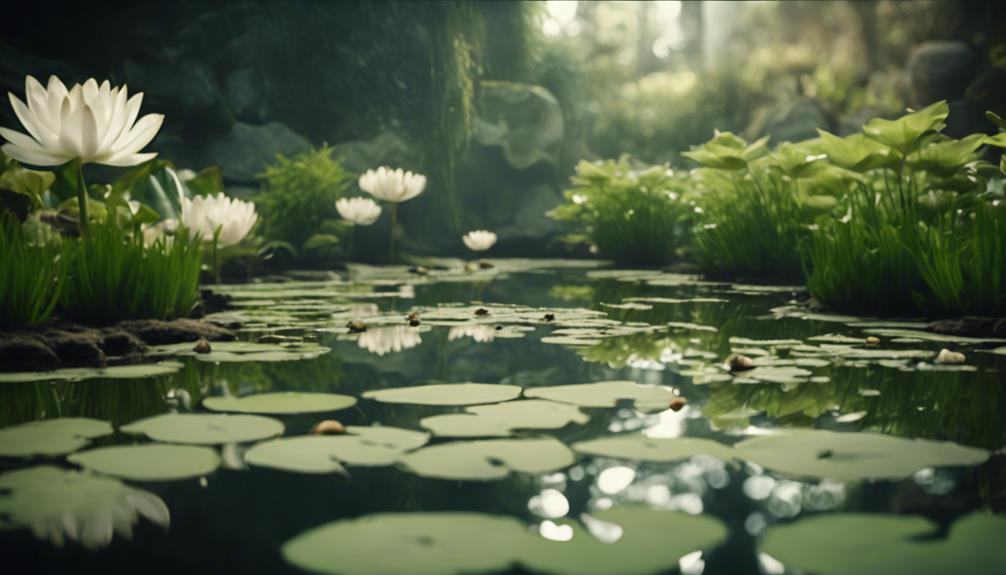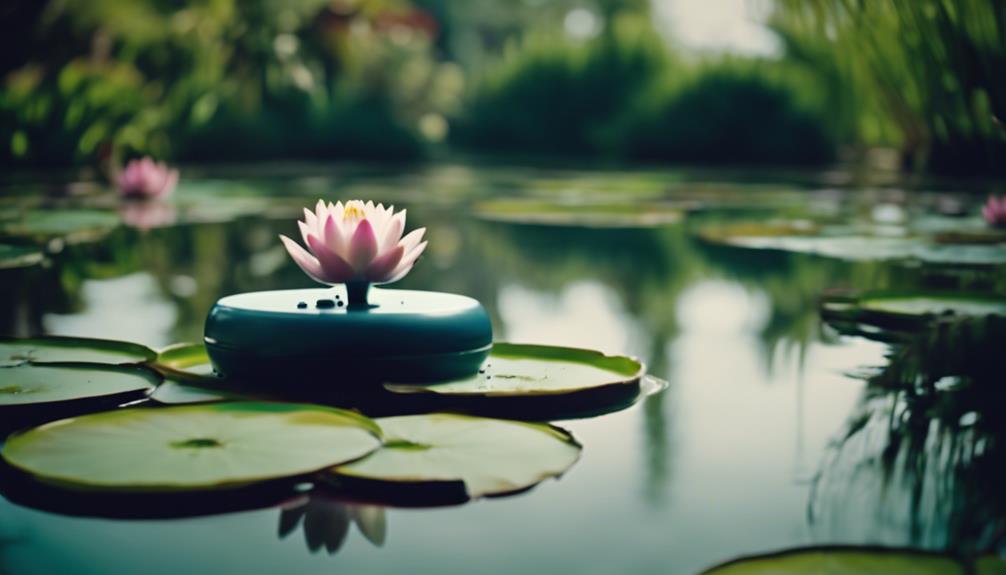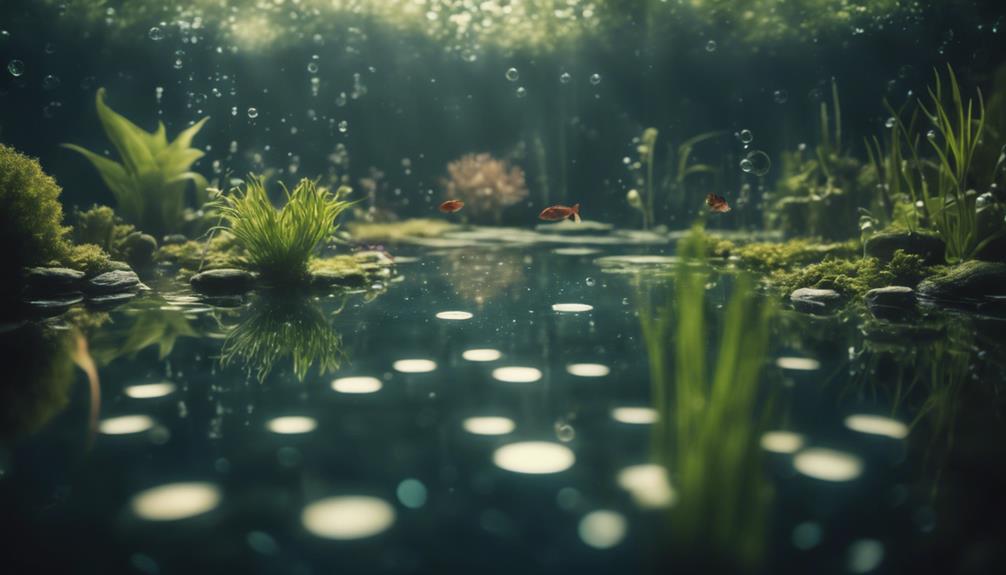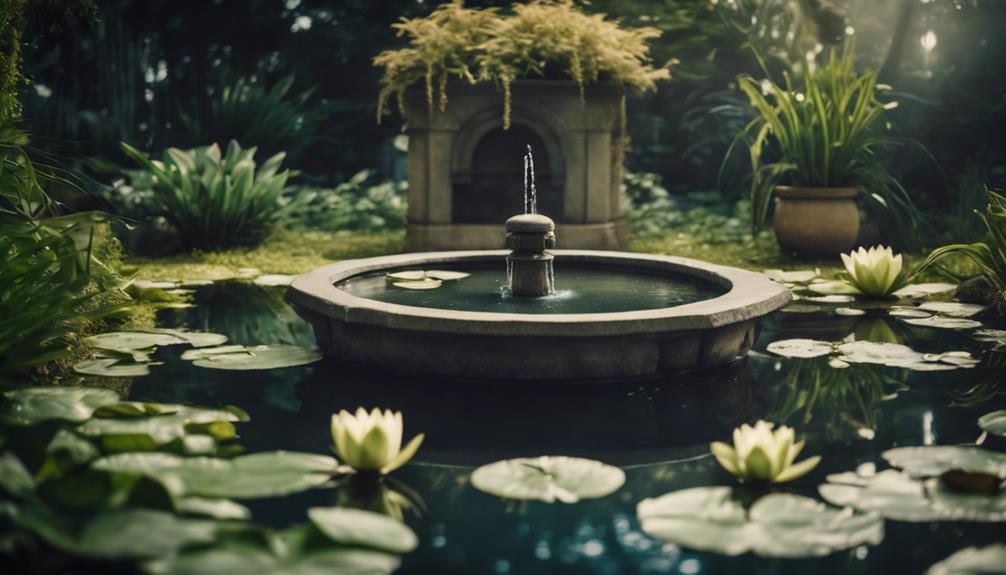You can oxygenate your water garden by incorporating oxygen-rich soil mix, creating an oxygen-rich water solution with hydrogen peroxide, adding aeration devices, increasing water movement and flow, and monitoring oxygen levels regularly. Oxygen-rich soil promotes healthy root growth, while the hydrogen peroxide solution introduces oxygen and promotes healthy root development. Aeration devices and increased water movement guarantee ideal oxygen levels, and regular monitoring helps detect deficiencies. By implementing these methods, you'll create a thriving ecosystem with healthy plants, aerobic bacteria, and vibrant aquatic life. Now, learn how to optimize these methods for a truly flourishing water garden.
Table of Contents
Key Takeaways
- Incorporate oxygen-rich soil mix with 1/3 tree bark, 1/3 vermiculite, and 1/3 sand for healthy root growth and development.
- Create an oxygen-rich water solution by mixing 1 pint of hydrogen peroxide with 1 gallon of water to boost plant growth by up to 30%.
- Add aeration devices to maintain ideal oxygen levels, introducing air into the water and supporting aerobic bacteria growth.
- Increase water movement and flow by installing a pump or fountain, or adding a water feature like a waterfall or stream.
- Monitor and maintain oxygen levels through regular testing, identifying signs of low oxygen and addressing causes to ensure a healthy environment.
Incorporate Oxygen-Rich Soil Mix

By mixing in porous materials, such as bark, rocks, and vermiculite, into your soil, you create an oxygen-rich environment that allows water and air to penetrate the soil, promoting healthy root growth and development.
This is especially vital in a water garden, where healthy roots translate to a healthy pond ecosystem.
By incorporating these materials, you're adding oxygen to the soil, which in turn improves water quality and supports a healthy pond.
A well-balanced soil mix with 1/3 tree bark, 1/3 vermiculite, and 1/3 sand can create an ideal environment for aeration and oxygenation.
This mix allows for perfect water movement, ensuring that oxygen reaches the roots of your plants.
By doing so, you're creating an environment that fosters thriving plants, which in turn contribute to a healthy pond ecosystem.
Create Oxygen-Rich Water Solution
You can further enhance your water garden's oxygen levels by creating an oxygen-rich water solution that gives your plants an extra boost of oxygen, beyond what's provided by the oxygen-rich soil mix. This solution can be easily made by mixing 1 pint of hydrogen peroxide with 1 gallon of water. The resulting oxygen-rich water solution can increase plant growth by up to 30%.
| Benefits | Description |
|---|---|
| Increase Dissolved Oxygen | Boosts plant growth by up to 30% |
| Introduce Oxygen | Promotes healthy root development and prevents root rot |
| Water with Oxygen | Provides an immediate oxygen boost for plants |
| Plant Growth | Increases yield by up to 20% |
To use this solution, shake the mixture vigorously for 5 seconds and let it sit overnight. This allows the extra oxygen in hydrogen peroxide to attach to roots, increasing nutrient uptake and growth. Additionally, hydrogen peroxide disinfects water, eliminating bacteria and impurities, making it a useful solution for treating mold and bad fungi. By using oxygen-rich water, you can promote overall healthy plant growth and development, giving your water garden the best chance to thrive.
Add Aeration Devices to Water

Installing aeration devices in your water garden is a crucial step in maintaining ideal oxygen levels, as they efficiently introduce air into the water, increasing circulation and dissolution of oxygen.
By adding an air pump to your pond, you'll be able to enhance the oxygenation process, which is especially important in warmer months when low oxygen levels can be detrimental to aquatic life.
Aeration systems work by breaking down water molecules, allowing oxygen to dissolve more easily, creating a healthy environment for aerobic bacteria to thrive.
This, in turn, supports the natural breakdown of organic matter, keeping your pond water clean and clear.
When you add a pond aeration device, you're not only improving oxygen levels but also increasing water circulation, which helps to reduce stagnation and prevent the buildup of toxic gases.
Increase Water Movement and Flow
To guarantee your water garden remains healthy and thriving, increasing water movement and flow is essential, as it helps to distribute oxygen-rich water throughout the pond.
You can achieve this by installing a pump or fountain, which will circulate oxygen-rich water throughout your pond. Aim for a minimum water flow rate of 10-15 gallons per hour to effectively oxygenate your small to medium-sized water garden.
Adding a water feature, such as a waterfall or stream, can also increase water movement and flow, thereby promoting oxygenation. For deeper areas of your pond, consider incorporating a submersed aerator or diffuser to enhance water circulation and oxygenation.
This will help to increase the amount of oxygen in your pond, creating a healthy environment for your aquatic life. Regular maintenance is key, so be sure to clean your pump and fountain regularly and maintain proper water levels to certify consistent water movement and flow.
Monitor and Maintain Oxygen Levels

Regular oxygen level monitoring is crucial, as it helps detect any deficiencies that could harm aquatic life, and making adjustments accordingly guarantees a healthy environment. You need to make sure your water garden has sufficient oxygen levels to support healthy aquatic life. Monitoring oxygen levels regularly helps you identify any potential issues before they become severe.
Some simple tips to help you monitor and maintain oxygen levels:
| Signs of Low Oxygen | Causes | Solutions |
|---|---|---|
| Fish gasping for air | Insufficient water circulation | Install a pond pump or aerator |
| Murky or stagnant water | Excessive organic matter | Add beneficial bacteria or clean the pond bottom |
| Algae growth | Excessive nutrients | Reduce amounts of water fertilizers or add algae-controlling plants |
| Slow fish movement | Inadequate oxygen supply | Increase water movement or add an oxygenator |
| Unusual fish behavior | Oxygen deficiency | Monitor oxygen levels regularly and adjust accordingly |
Frequently Asked Questions
How Do You Oxygenate Water Quickly?
When you need to oxygenate water quickly, you'll rely on emergency measures like oxygen boosters, water churners, or fast bubblers to provide rapid circulation and aeration, while rapid agitators can also help increase oxygen levels in a pinch.
How Do You Oxygenate Water to Water Plants?
When you oxygenate water for plants, you're ensuring healthy root development by improving water circulation and flow, which depends on plant selection, soil quality, and aeration systems that promote ideal water flow and circulation.
What Is the Most Efficient Way to Oxygenate Water?
You'll find the most efficient way to oxygenate water is through Nanobubble Technology systems, which produce high diffusion rates, creating oxygen bubbles that stay in solution, outperforming traditional aeration devices, pump systems, and air stones that rely on water circulation.
How Can I Naturally Oxygenate My Pond?
Did you know 85% of pond oxygenation occurs at the surface? You can naturally oxygenate your pond by optimizing pond aeration through water flow, fostering natural bacteria, and incorporating aquatic plants, which create surface ripples, especially at varying pond depths.
Conclusion
As you've now turbocharged your water garden with these 5 easy ways to oxygenate it, you're basically flipping the switch on a aquatic oxygen factory!
With oxygen-rich soil, water solutions, aeration devices, increased water movement, and regular monitoring, you're creating a thriving ecosystem.
Remember, oxygen is the lifeblood of your aquatic friends, so keep those levels topped up and your water garden will be the cat's pajamas!

